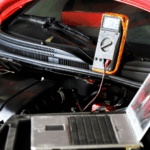Your car doesn’t care what the calendar says. It responds to what Mother Nature throws at it, and that changes everything about when and how you should maintain your vehicle. I’ve watched cars in Minneapolis rust out in three years while identical models in Nashville last twice as long. The weather where you drive doesn’t just affect your commute, it completely rewrites your maintenance schedule.
- Salt exposure in northern states can destroy brake lines and undercarriages in just a few winters
- High humidity in southern climates creates different problems like mold in cabin air filters and electrical issues
- Extreme temperature swings stress everything from engine seals to tire compounds
The Salt Belt Reality Check
Here’s what nobody tells you about buying a used car: if it came from the Salt Belt, you’re looking at a completely different maintenance situation. Road salt is a common cause for corrosion of automobile parts, and vehicles in the Salt Belt often experience more rapid rusting compared to other regions of the country, often requiring more frequent maintenance as brake lines, electrical wiring, and structural components are adversely affected.
I know a guy who moved from Phoenix to Minneapolis with his five year old pickup truck. Within two winters, he was replacing brake lines, dealing with corroded electrical connections, and watching his truck’s undercarriage turn into Swiss cheese. That’s not an accident, that’s chemistry.
The damage starts the moment temperatures hit the sweet spot for corrosion. Sodium chloride becomes continuously corrosive above 10 C (50 F) and 76 percent relative humidity (RH). Most is washed away with heavy rain in the spring before those conditions are regularly met. But here’s the catch: that narrow window between winter and spring cleaning is when the real damage happens.
Smart car owners in Minneapolis have learned to schedule undercarriage washing every two weeks during winter. They’ve figured out that waiting until spring means dealing with permanent corrosion instead of just cleaning off salt residue. The local car washes make most of their money between February and April for exactly this reason.
Southern Humidity and Your Car
Nashville drivers face a completely different set of challenges. While they rarely deal with road salt, I lived in Nashville for 3 years, it only snowed several times and never more than 0.5″ accumulated (melted within hours of the snow stopping if there was enough to accumulate which I only recall one time in those 3 years). They did not salt the roads as far as I knew, the humidity creates problems that northern drivers never consider.
Ever notice how cars in humid climates develop that musty smell faster? That’s moisture getting into places it shouldn’t be. Cabin air filters in Nashville need changing twice as often as the same filters in Denver. I’ve seen perfectly good air conditioning systems develop mold in the evaporator cores just from sitting in humid air.
The electrical systems take a beating too. Moisture finds its way into connections, causing corrosion that’s different from salt damage but just as expensive. I know a mechanic in Nashville who says he replaces more alternators and starters than his counterpart in Phoenix, simply because humidity accelerates electrical component failure.
Oil changes become more critical in humid climates. Moisture gets into the oil system through normal engine breathing, and that leads to faster oil breakdown. Cars that might go 7,500 miles between oil changes in dry climates often need service every 5,000 miles in consistently humid areas.
Temperature Extremes and Vehicle Stress
Some regions hit your car with everything at once. In Greenwood, the summers are long, warm, humid, and wet; the winters are short, very cold, snowy, and windy; and it is partly cloudy year round. This kind of climate puts vehicles through extreme stress cycles.
Think about what happens to your engine when it’s running at 195°F while the outside air is 95°F, then six months later it’s trying to start at 10°F. Those temperature swings affect everything from gasket seals to tire compounds. Cars in areas like Greenwood in Indiana need more frequent inspection of seals, hoses, and belts because the constant expansion and contraction weakens materials faster.
Tire wear patterns change dramatically with temperature swings. Hot pavement in summer makes tires wear differently than cold pavement in winter. I’ve seen tire shops in mixed climates recommend rotation every 3,000 miles instead of the usual 5,000 to 6,000 miles just to manage uneven wear from temperature changes.
Battery life takes a serious hit in extreme climates. A battery that might last five years in moderate weather often fails in three years when dealing with both blazing summers and freezing winters. The chemical reactions inside batteries slow down in cold and speed up in heat, both of which reduce overall battery life.
Regional Maintenance Strategies That Work
The best mechanics I know don’t use one size fits all maintenance schedules. They adjust based on local climate reality. In Minneapolis, they front load winter prep. Get your coolant flushed, battery tested, and undercarriage protected before October. Once winter hits, it’s all about damage control until spring.
Nashville shops take a different approach. Summer is for major engine work when you can’t stand driving anyway. Spring and fall are for exterior work like paint correction and undercarriage cleaning. They’ve learned that trying to detail a car in 95°F heat with 85% humidity is just throwing money away.
One shop owner told me they basically run two different service calendars. Winter prep starts in September with heating system checks, antifreeze testing, and battery replacement. Summer prep starts in March with air conditioning service, cooling system flushes, and tire inspections.
The Real Cost of Climate
Weather affects your car’s maintenance budget more than most people realize. I’ve tracked maintenance costs across different climates, and the differences are shocking. Cars in salt exposed areas need brake line replacement every four to six years instead of eight to ten years. Results from this effort confirmed that (1) increasing chloride concentrations increased galvanic corrosion and dezincification; (2) chloride levels did not impact stainless steel corrosion; and (3) metal leaching, thinning of plumbing materials, and degradation of aesthetic water quality must be considered when evaluating the impact of road salt on drinking water.
That corrosion research applies directly to your car’s brake lines, fuel lines, and exhaust system. Salt doesn’t just make things look bad, it makes them fail faster and more expensively.
In humid climates, air conditioning repairs cost 40% more on average because moisture damage affects multiple components simultaneously. What starts as a simple refrigerant leak becomes a compressor replacement because humidity has corroded the entire system.
Climate Change Shifts the Game
Just when car owners think they understand their local maintenance needs, climate patterns start changing. In a typical year around 1990, people in Minneapolis, MN experienced about 7 days above 91.8ºF in a year. By 2050, people in Minneapolis are projected to experience an average of about 35 days per year over 91.8ºF.
That’s five times more extreme heat stress on cooling systems that were designed for occasional hot days. Air conditioning systems, radiators, and cooling fans that used to last the life of the car now face regular replacement. Northern cars are starting to need southern style cooling system maintenance.
The annual precipitation in Minneapolis, MN is projected to increase from about 29.8″ to about 31.9″. More rain might help wash away salt, but it also means more humidity, more moisture in fuel systems, and more electrical problems from water infiltration.
Technology Helps Track Conditions
Modern cars are getting smarter about adapting to local conditions. Some newer vehicles adjust maintenance schedules automatically based on driving conditions and climate data. Your car’s computer tracks temperature extremes, humidity levels, and driving patterns to recommend service intervals that match your actual conditions.
I know car owners who use weather apps to time their maintenance. When humidity drops below 60% for a week, that’s when they schedule electrical work. When salt forecasts show a clear period, they book undercarriage cleaning. It’s like having weather aware car care.
Practical Climate Based Maintenance
Here’s what I’ve learned from talking to mechanics across different climates: your maintenance schedule should match where you actually drive, not what the owner’s manual suggests for average conditions.
In salt belt states, wash your car’s undercarriage monthly during winter. Don’t wait for spring. Schedule brake inspections twice a year instead of annually. Replace cabin air filters every six months instead of yearly.
In humid climates like Nashville, change your oil more frequently. Check electrical connections during routine service. Run your air conditioning regularly, even in winter, to keep the system dry and prevent mold growth.
In temperature extreme areas, inspect belts and hoses every six months. Test your battery twice a year. Rotate tires more frequently to manage uneven wear from temperature-related pavement changes.
Working With Weather Reality
Your car lives in the real world, not in laboratory test conditions. Whether you’re dealing with salt spray in Minneapolis, humidity battles in Nashville, or temperature extremes in places like Greenwood, in, your maintenance approach needs to match your climate reality.
Stop following generic maintenance schedules that pretend all cars live in perfect conditions. Your car doesn’t live there, and neither should your maintenance budget. Adjust your service intervals for actual weather conditions, and you’ll save money while keeping your car running longer.
The cars that last longest aren’t necessarily the best built ones. They’re the ones maintained by owners who understand that climate isn’t just background noise, it’s the main factor determining how often your car needs attention.







Leave a Reply